Shopify In Cart Upsell Guide 2025: Expert Tips & Real Examples
Last updated on
December 12, 2025
.webp)
Your customer has already found something they love and added it to the cart. They’re ready to buy - that’s the perfect moment to show them something extra. This is exactly what a Shopify in cart upsell does: it turns a single-product purchase into a bigger, more rewarding order for both you and your customer.
Why choose in cart upsells in Shopify?
In cart upsells are one of the most effective ways to boost your average order value — and the best part is, the impact is almost instant. By showing the right offers at the right time, you can turn a single-product purchase into a bigger, more valuable order without interrupting your customer’s shopping flow.
1. Pick the right products for maximum impact
The products you choose for your upsell make all the difference.
This step can determine whether your customer adds more to their cart - or skips the purchase entirely.
Pick products that genuinely complement what’s already in their cart.
For example, if they’ve added a coffee mug, offering a matching coaster set or premium coffee beans feels natural and thoughtful.
2. Make the decision easy for your customer
At this stage, your customer has already decided to buy.
They’re moments away from checking out - which means it’s the perfect time to show them something simple and irresistible.
The key is to make the choice effortless - a “why not” decision rather than a “let me think about it” one.
3. Create a sense of added value
Everyone loves feeling like they’re getting more for less.
When customers see that they can add an extra product at a discounted price, it instantly feels like a better deal.
Instead of buying just one item, they walk away with a small bundle - and that sense of value encourages them to click “Add” without hesitation.
Examples of good and bad cart upsells in shopify
When it comes to in cart upsells, not every offer works the same. The trick is to make your upsells feel natural, helpful, and relevant to what your customer is already buying. Here’s a quick guide with real examples:
1. Complementary products
- Good example: Customer adds a smartphone → Upsell shows a protective case or charging cable.
- Bad example: Customer adds a laptop → Upsell shows a blender.
- Why it matters: Complementary products makes the main purchase better or easier. Irrelevant items, on the other hand, feel random and can frustrate shoppers.
2. Add-ons / Low-cost extras
- Good example: Customer buys a camera → Upsell offers a memory card or lens cleaning kit for $5–10.
- Bad example: Customer buys a coffee maker → Upsell shows a frying pan.
- Why it matters: Small, affordable add-ons are easy for customers to say “yes” to and boost your average order value without hesitation. Add-ons that don’t fit the product feel pointless and can lower trust.
3. Upgrades / Premium versions
- Good example: Customer adds a standard coffee maker → Upsell shows a deluxe model with extra features.
- Bad example: Customer buys a $20 speaker → Upsell shows a $400 sound system.
- Why it matters: Upgrades should feel like a natural next step, giving the customer more value. A huge price jump, however, feels jarring and can discourage purchase.
Tip: Always think like your customer - each upsell should feel helpful, not pushy. When done right, complementary products, add-ons, and upgrades can significantly increase your store’s revenue while keeping your shoppers happy.
Do’s and dont’s of Shopify in cart upsell
.webp)
Different strategies of in cart upsells
Now you know that in cart upsells are a great way to boost sales, let’s see the different ways in which you can do this.
Depending on how your cart is set up, be it a full cart page or a slide-out cart drawer, you can customize your upsell strategy to fit your customer’s journey.
1. Cart page upsell
In this setup, the customer lands on a dedicated cart page to review their order - a stage where buying intent is already high.
The best part about the full cart page is its spacious layout. You have plenty of room to display upsell products, show detailed descriptions, or highlight customization options. It’s a classic shopping experience that many customers still prefer.
It’s also perfect for upgrades, like premium versions of products, or items that need a little explanation - such as personalized jewelry, print-on-demand apparel, or subscription add-ons. This way, customers can make thoughtful decisions without leaving the checkout flow.
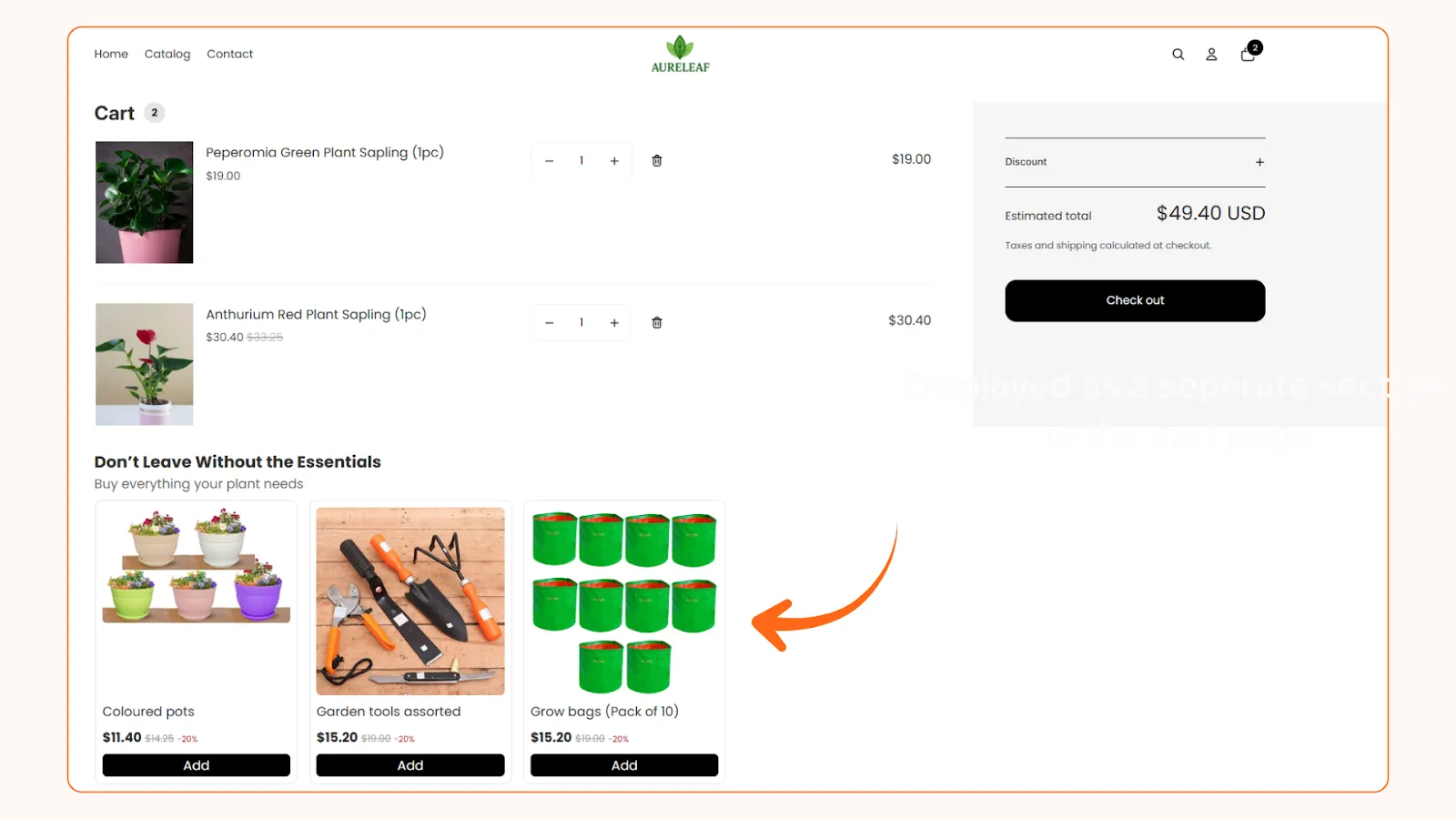
2. Slide cart / cart drawer upsell
With this setup, the cart slides in from the side whenever a customer adds an item - keeping them on the same page for a quick, smooth shopping experience.
Since it doesn’t interrupt the shopping flow, the cart drawer usually sees higher engagement. Customers can easily view, edit, or add recommended products without losing their place.
It also gives a modern, mobile-friendly feel that’s perfect for fast shoppers who value convenience.
This setup works best for low-cost add-ons like phone cases, screen guards, plant pots, or batteries - simple products customers can add without overthinking.
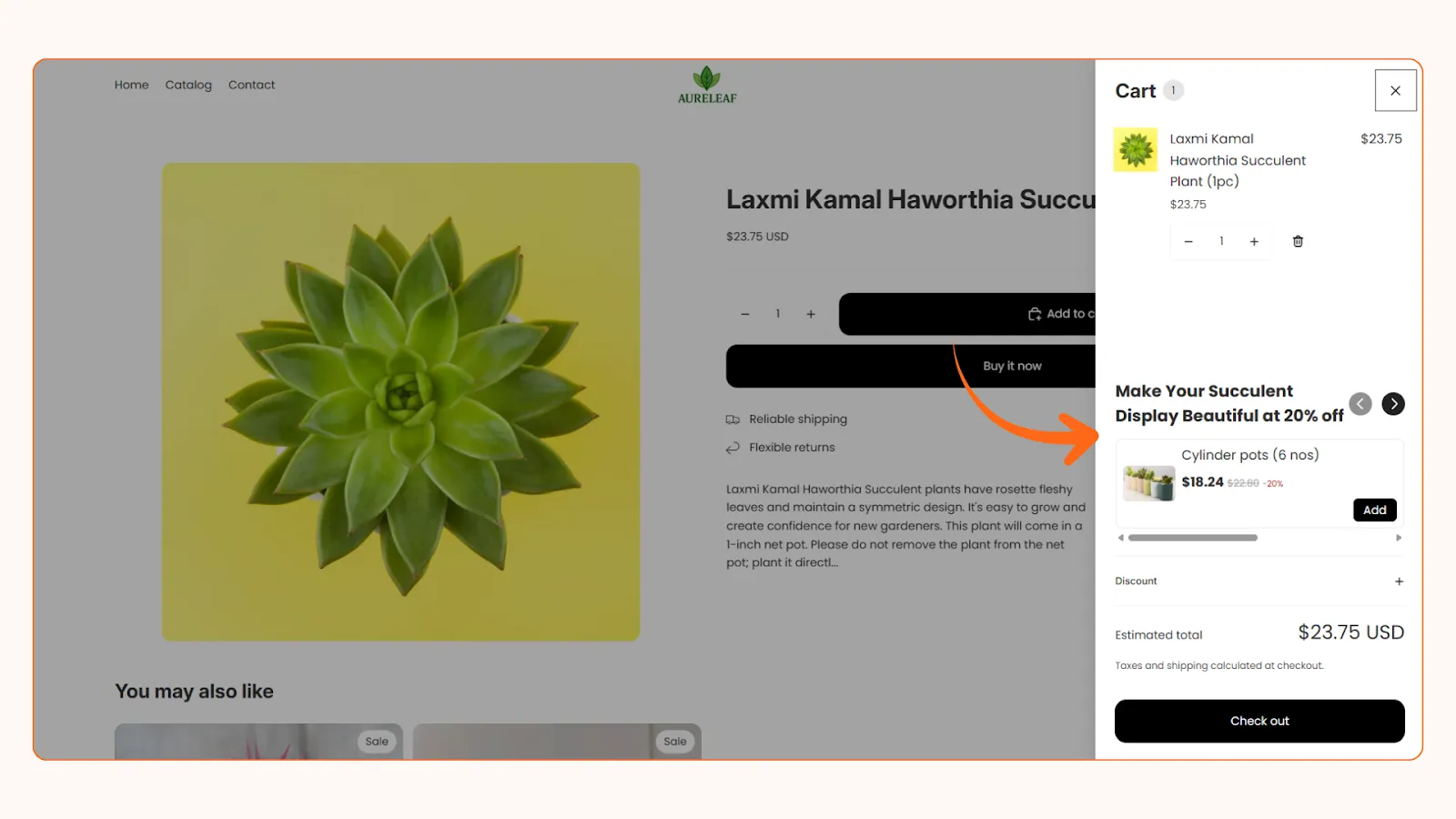
Apart from the upsell strategies on the cart page or cart drawer, there are a few more ways to increase your average order value.
These include
- Upsell pop up before checkout (with single or multiple products)
- Gamification using a cart progress bar
- Volume discount nudges in the cart
3. Upsell pop up before checkout (with single or multiple products)
It’s a bold move, but when done right, it can work wonders.
The key is choosing the right items - small add-ons that add value without making the customer overthink.
Think accessories, discounted warranties, or gift wrapping. A thoughtful nudge like this can boost your sales while keeping the checkout flow smooth.
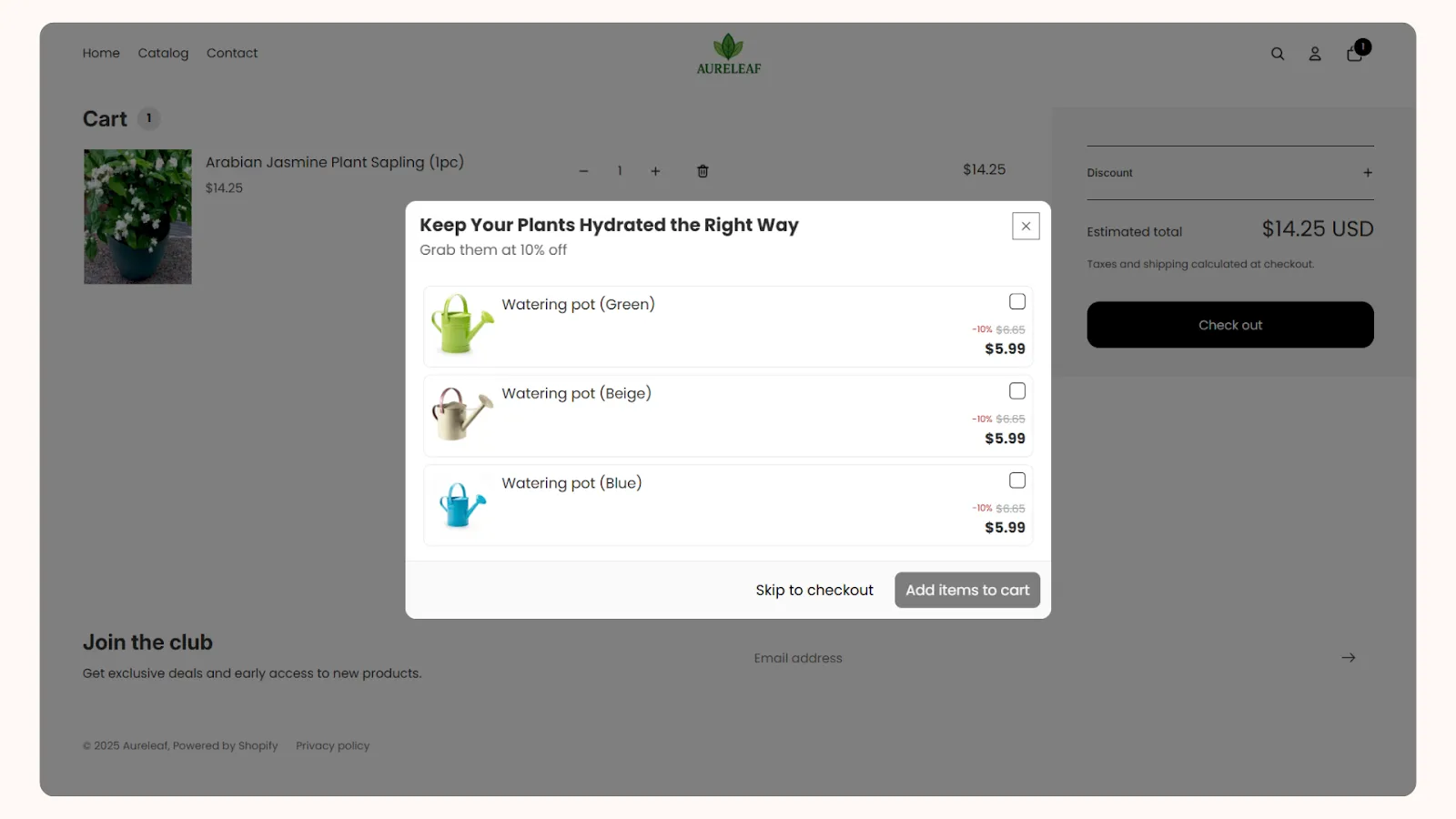
4. Gamification using a cart progress bar
Picture this - you’re shopping online, and as you add items to your cart, a little progress bar starts to move.
It shows how close you are to unlocking a free gift or special offer. Just a few more dollars, and the reward is yours.
That simple visual cue makes shopping feel more exciting, right? It gently encourages your customer to add one more item - not because they have to, but because they want to hit that goal.
And while your customer enjoys that little win, your store benefits too by increasing its average order value. It’s a win-win for both sides.
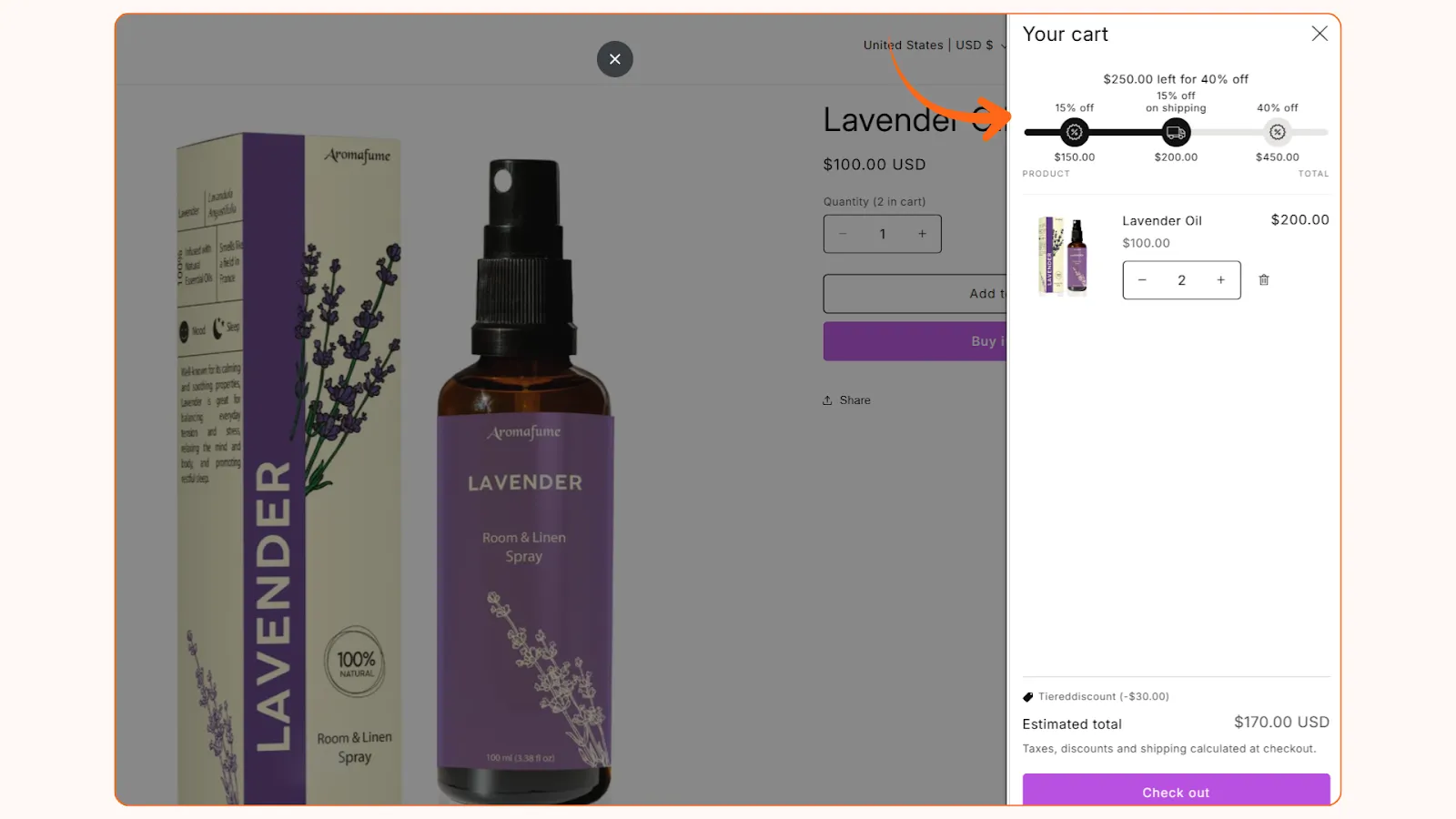
5. Volume discount nudges in the cart
Imagine this - you’re on the cart page, and a small message pops up: “Just $10 more for free shipping!” or “Add one more item to get $5 off.”
This is a volume discount nudge. It’s a simple way to reward your customers for buying a little more by reducing the per-unit price.
That gentle reminder often encourages them to reach the next tier, while you benefit from a higher average order value.
It’s a win-win - your customer gets a better deal, and you get a bigger order.
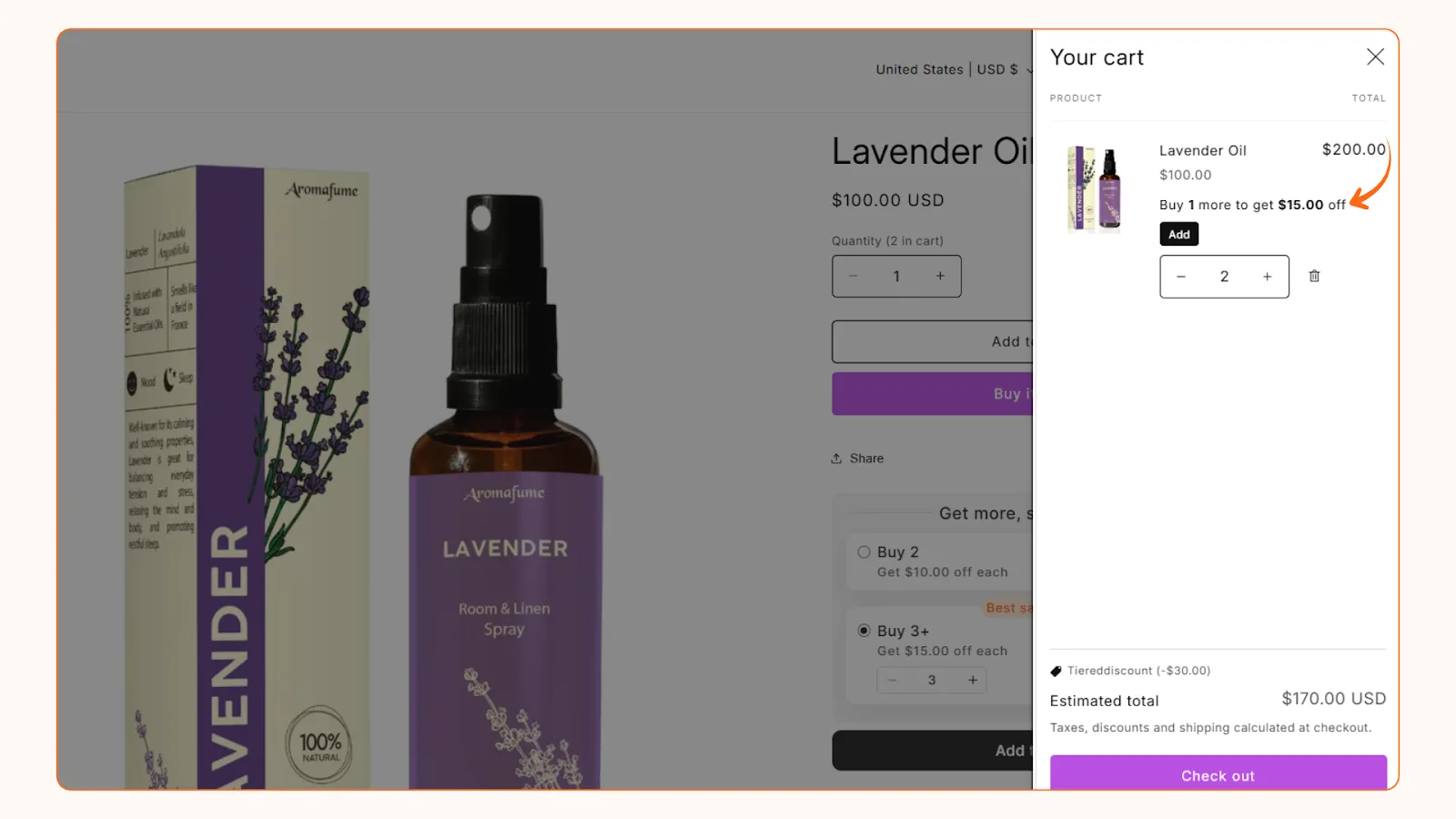
Now that you understand the different strategies of in cart upsells, let’s see how you can create them step by step in your Shopify store.
Install the Selleasy app from the Shopify store.
How to set up Shopify upsells in the cart page?
Step 1: Select in cart upsell and choose the products for which you want the upsell offer to appear. This helps you control exactly where and when the offer should be shown
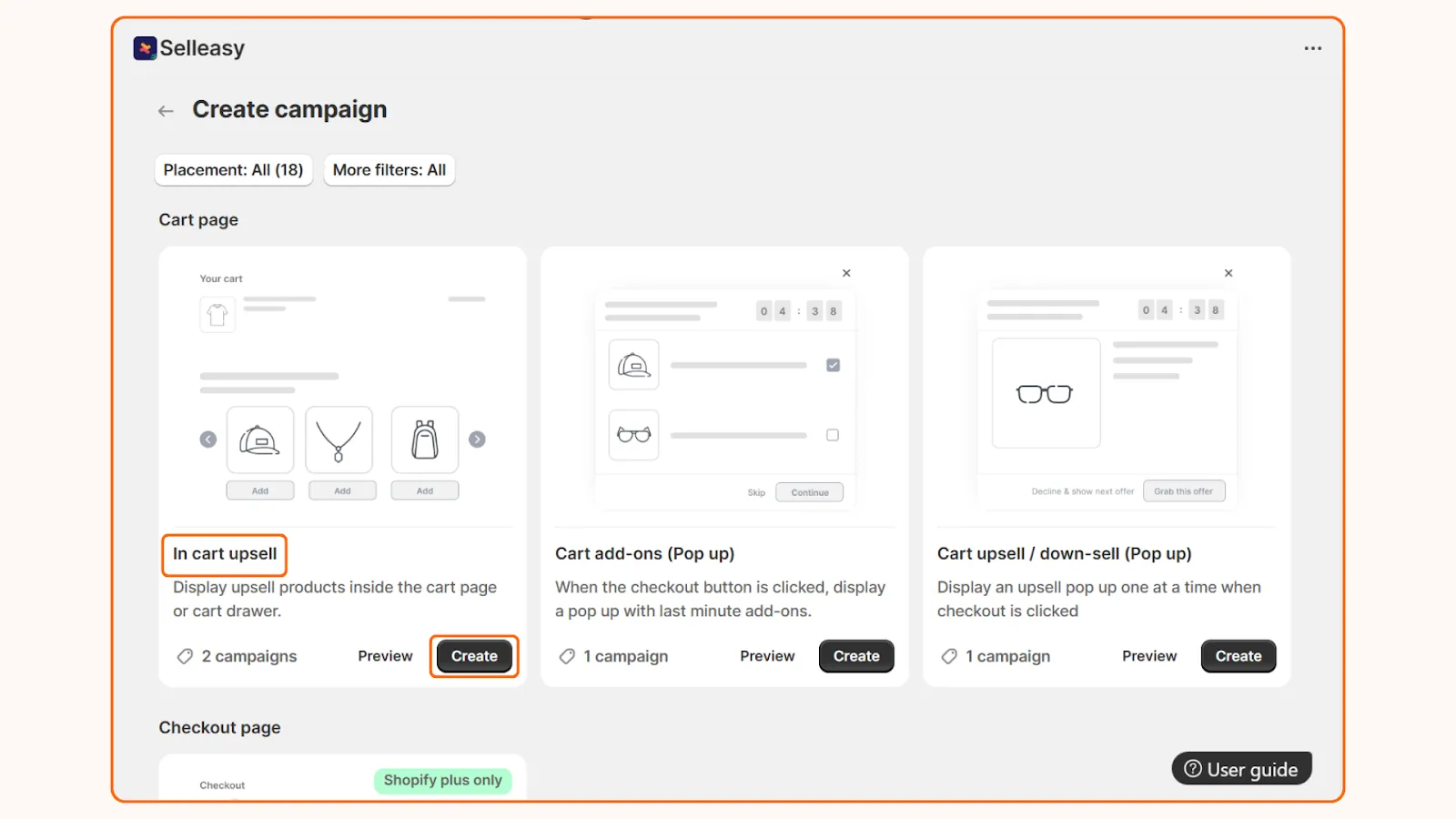
Start by choosing your main products and offer products
For example, let’s say you pick any three plants from your store as the main product. Then, you add a few accessories as upsell offers for these products.
This means that whenever a customer adds any of those main plants to their cart, the upsell products will automatically appear on the cart page.
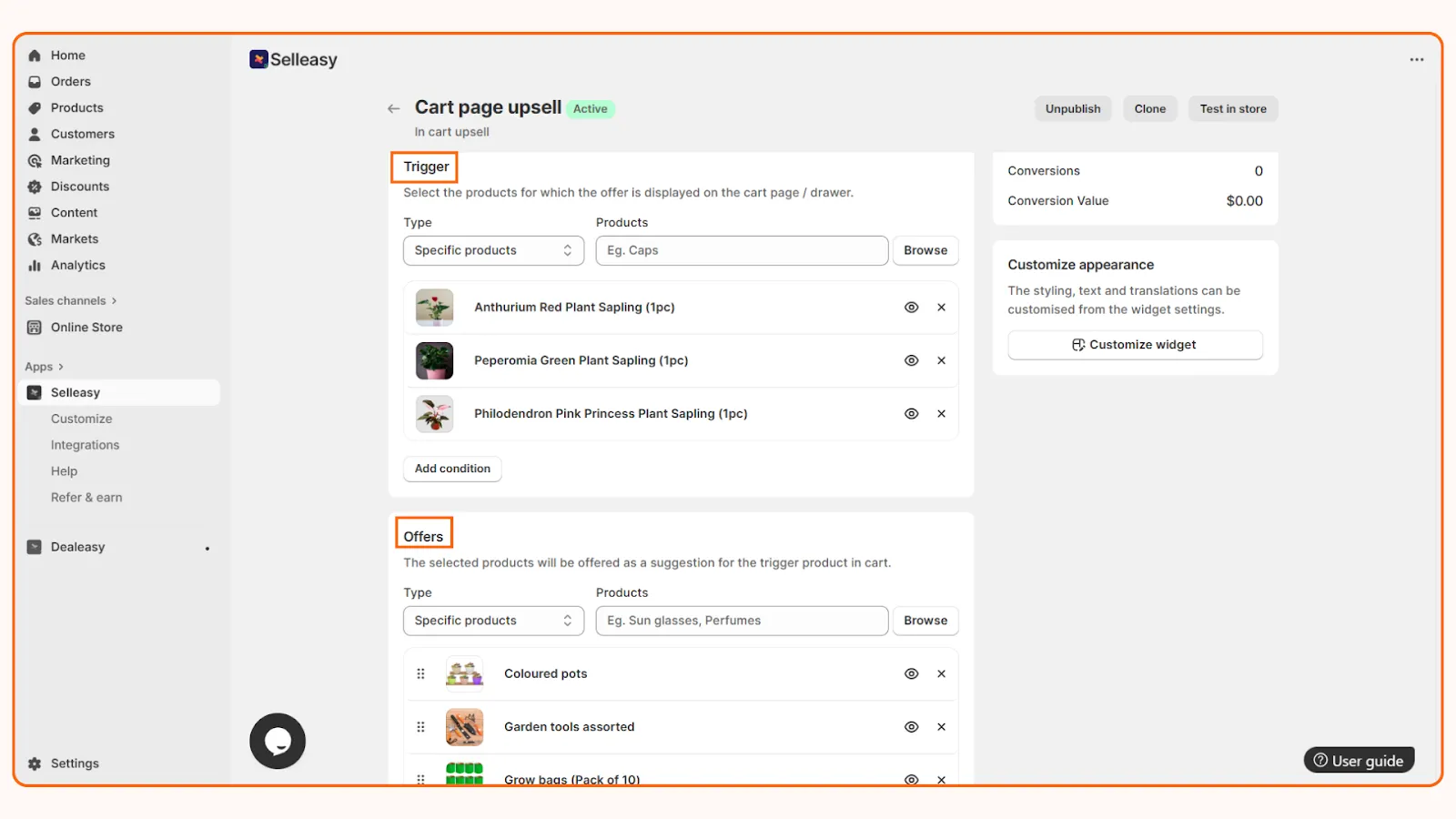
This is a smart way to increase the average order value of your store.
Step 2: Optionally, you can create discounts for the cart page upsell products.
Isn’t it tempting to add an extra product to the cart when there is a discount offered?
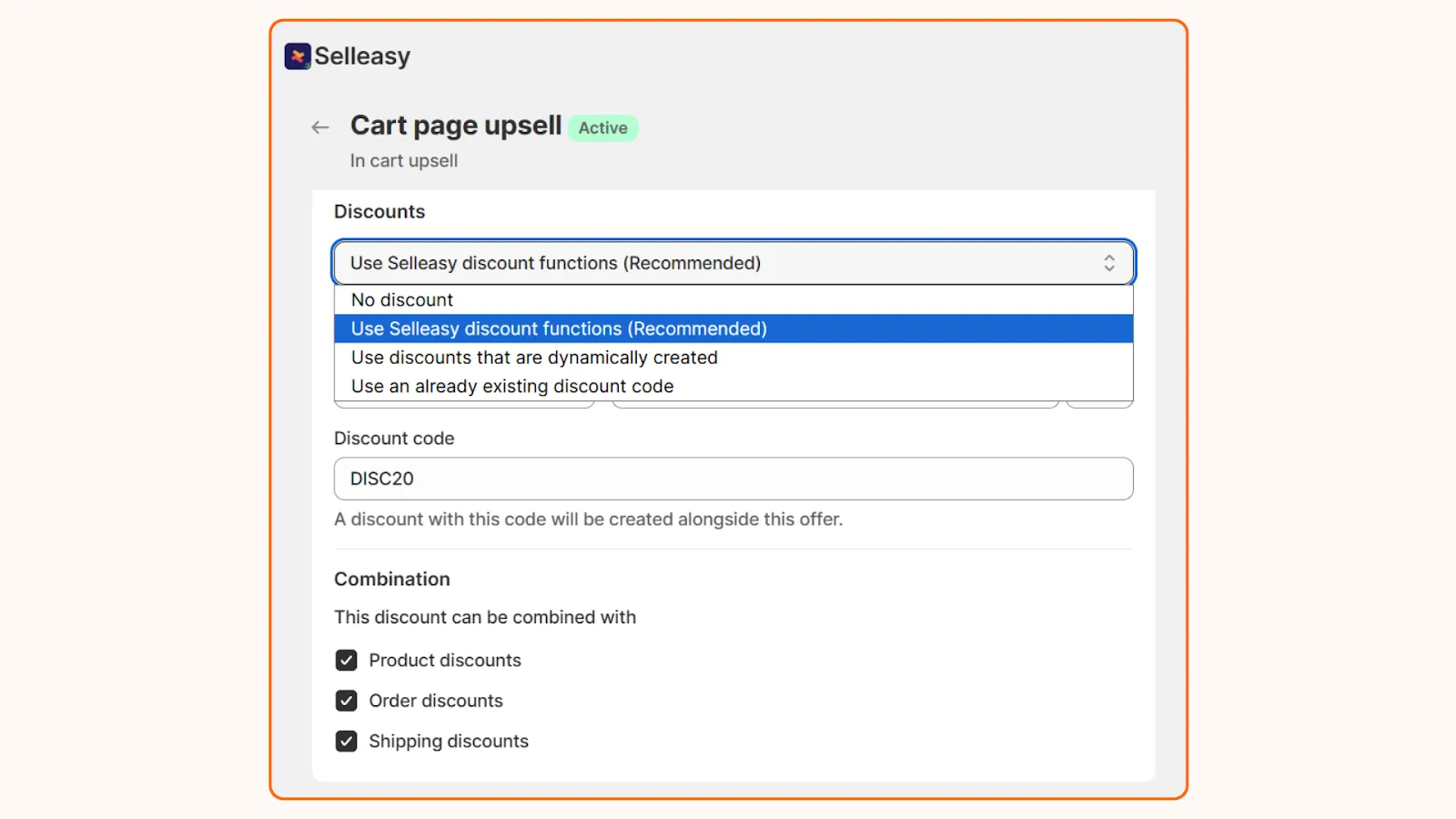
This is perfect for making your customers buy more.
Step 3 : Use irresistible titles that grab attention and spark an action
Your upsell headline should make customers pause and think, “Oh, that’s a great deal!” .
FA well-crafted title can be the difference between a skipped offer and an extra item added to the cart.
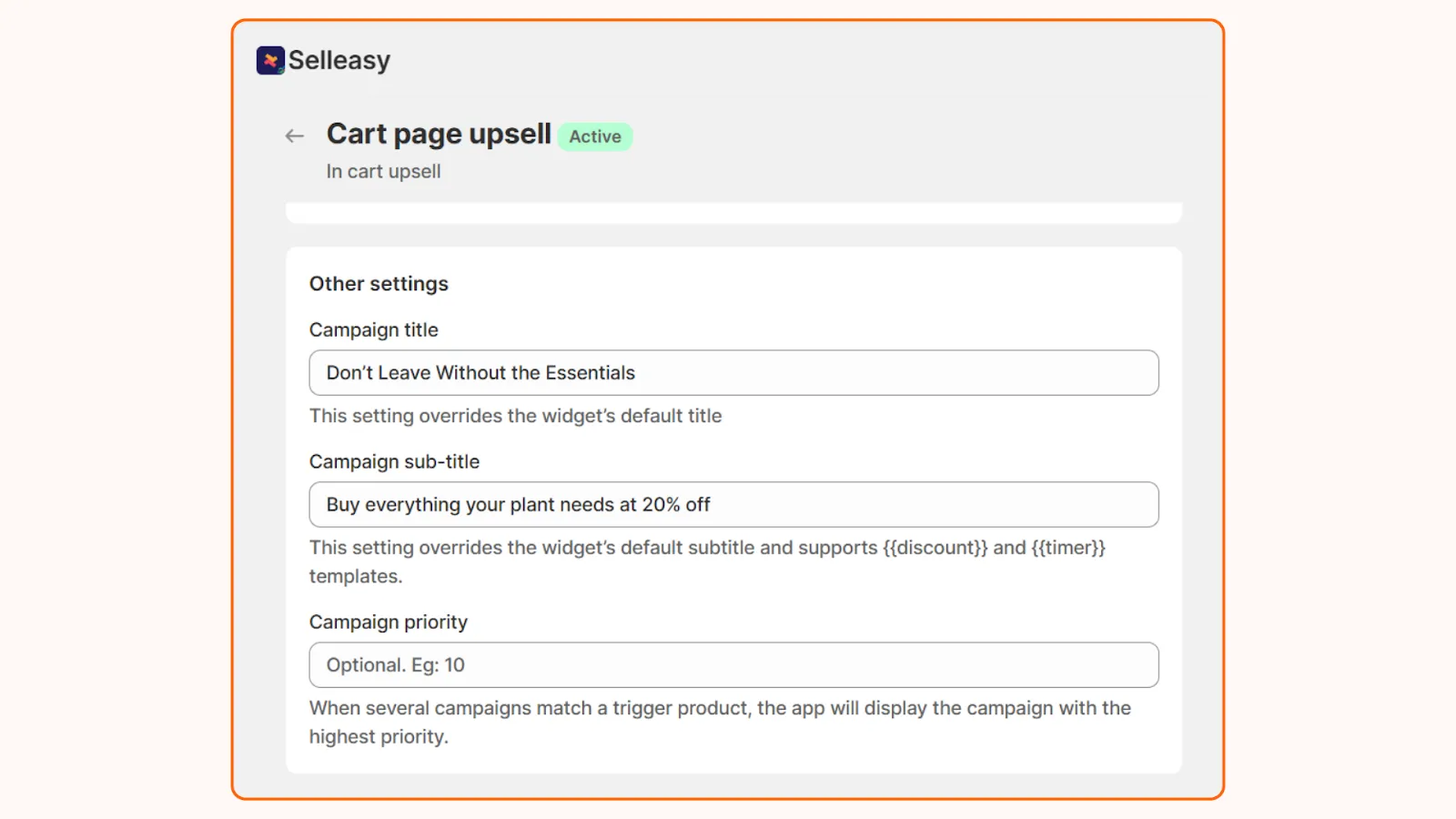
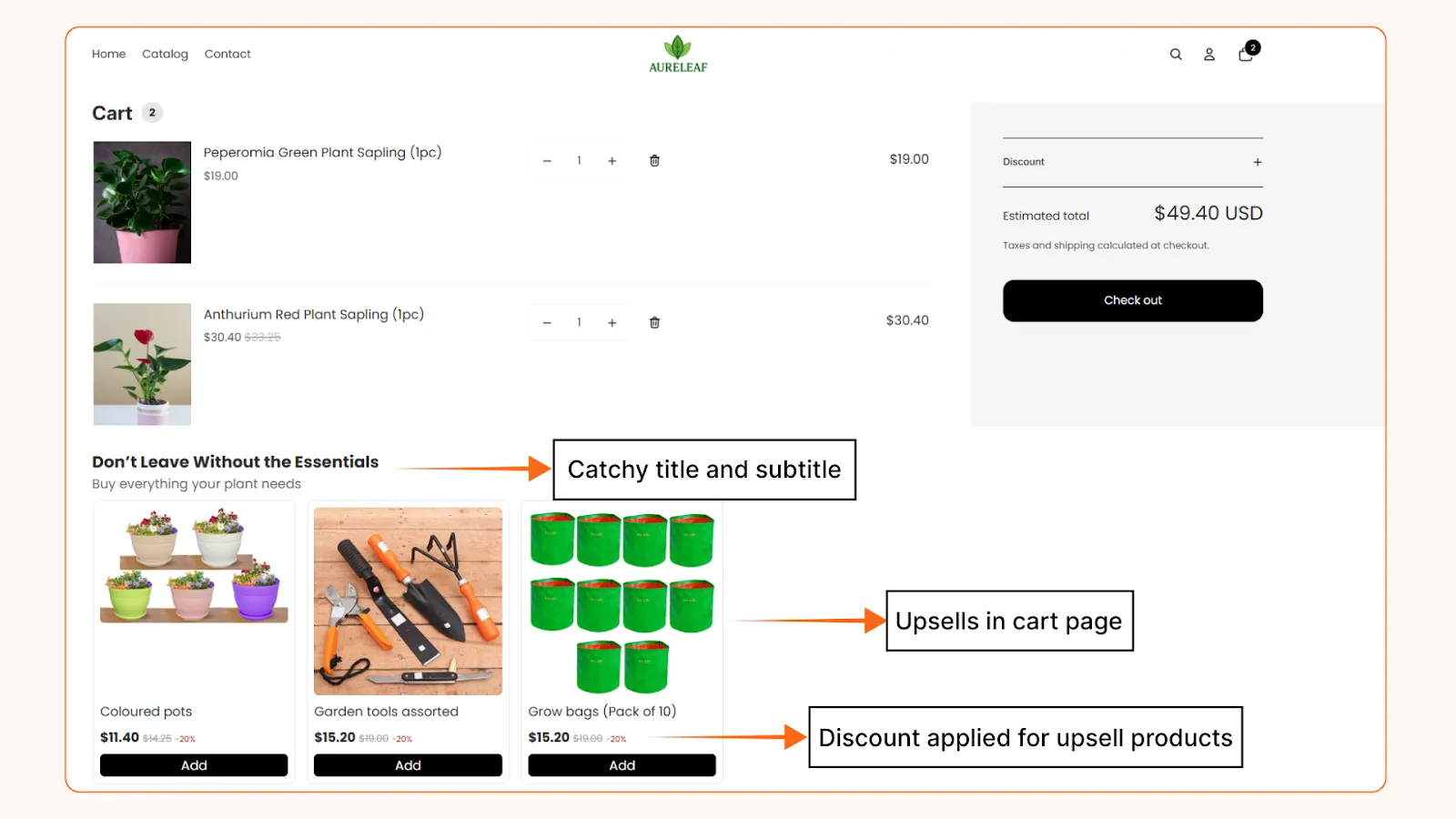
How to set up Shopify upsells in the cart drawer?
Now that you’ve seen how a Shopify in cart upsell works on the full cart page, let’s move on to the cart drawer experience.
The setup flow is almost the same - you’ll still select your main products, upsell products, and layout preferences. However, the placement and user experience are quite different.
Unlike the cart page, Shopify doesn’t support app blocks inside the cart drawer. So the upsell placement has to be done using custom positioning.
The Selleasy app makes this easy - it allows you to position in cart upsells inside the cart drawer using a simple custom code, compatible with any Shopify theme. This step requires just a basic level of technical familiarity.
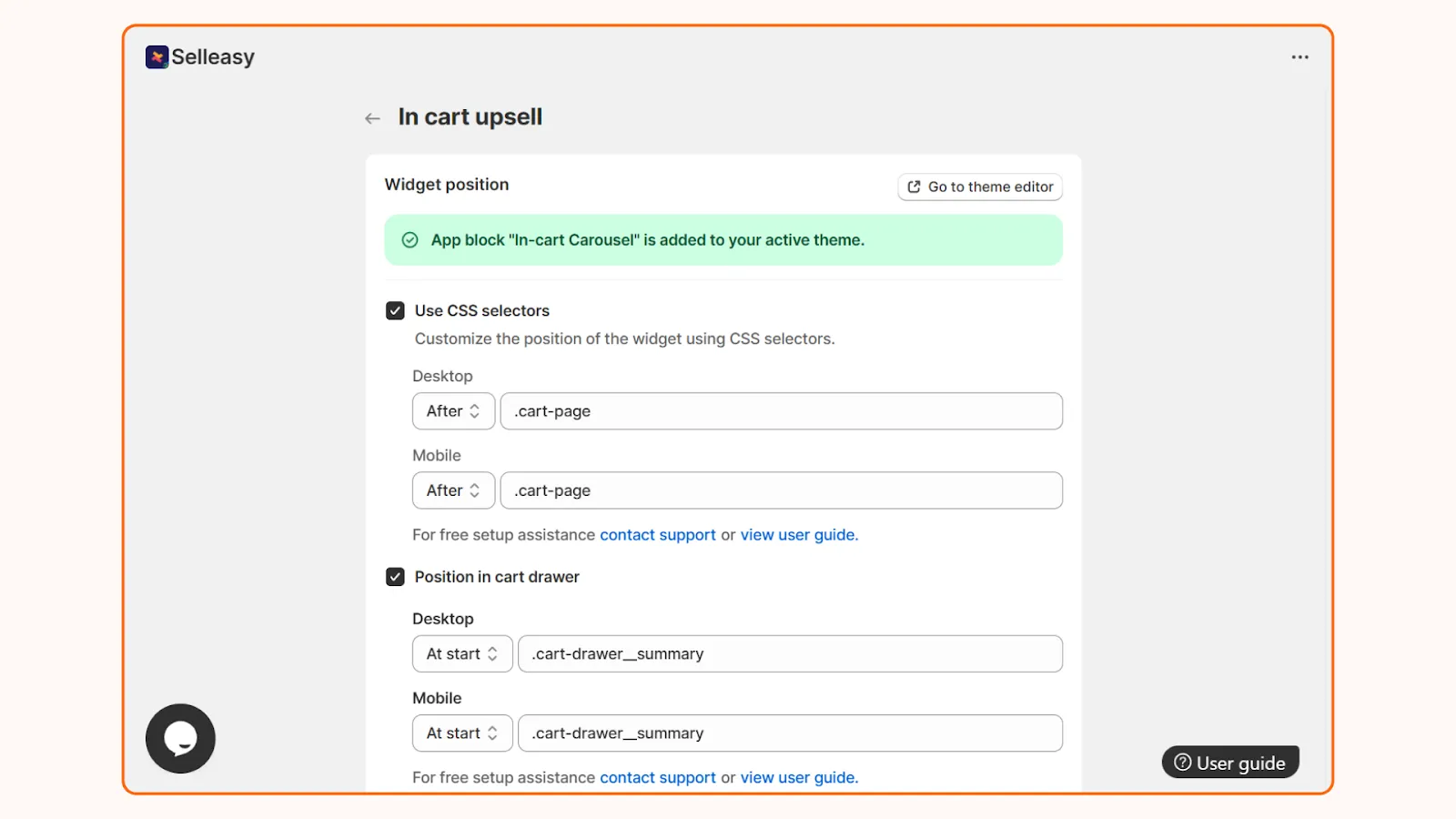
In this setup, the focus is on speed and subtlety - the upsell appears instantly inside the drawer, keeping the customer fully in their shopping flow without redirecting them to another page.

How to create an upsells pop-up based on the Shopify cart?
When it comes to cart upsells, you can show them either on the cart page or inside a cart drawer. Both work well while the customer is still shopping.
But checkout-triggered pop-up upsells are different. These appear right when your customer clicks the checkout button - at the exact moment they’re ready to buy.
It’s a strategic move, and when done thoughtfully, it can significantly boost your average order value.
With this method, you have full control.
You can either display multiple products in a single pop-up or offer one product at a time - depending on how focused or flexible you want the experience to be.
The best part? The setup process is the same as before. The only thing you decide is how you want the upsells to appear.
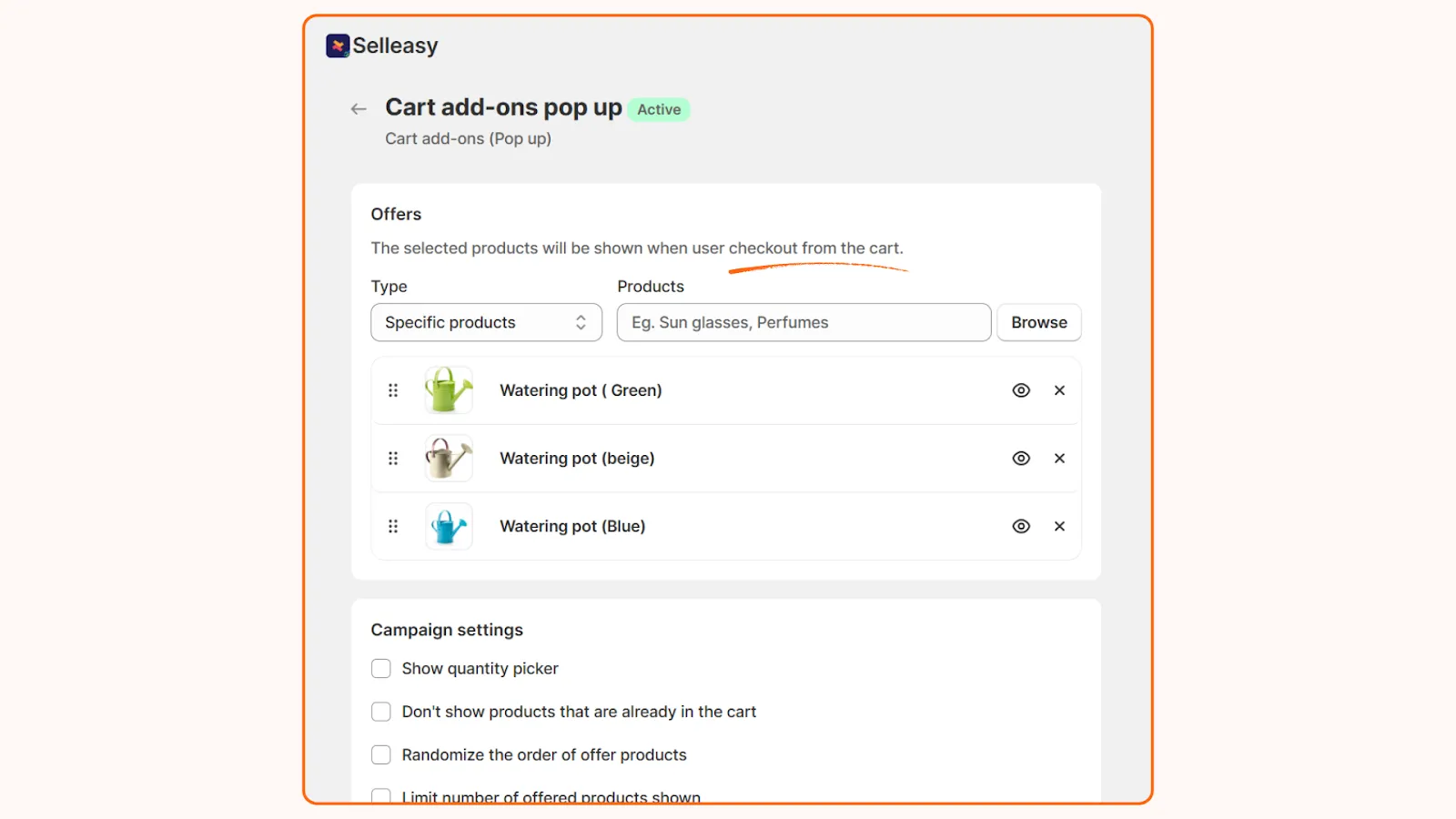
If you want to show a selection of products at once, go with the Cart Add-ons popup. It gives your customer a quick, clear view of all the offers - making it easy for them to pick what they love without leaving the checkout flow.

On the other hand, if you want a more focused and frictionless experience, you can choose to show one offer at a time - using a Cart upsell / down-sell.
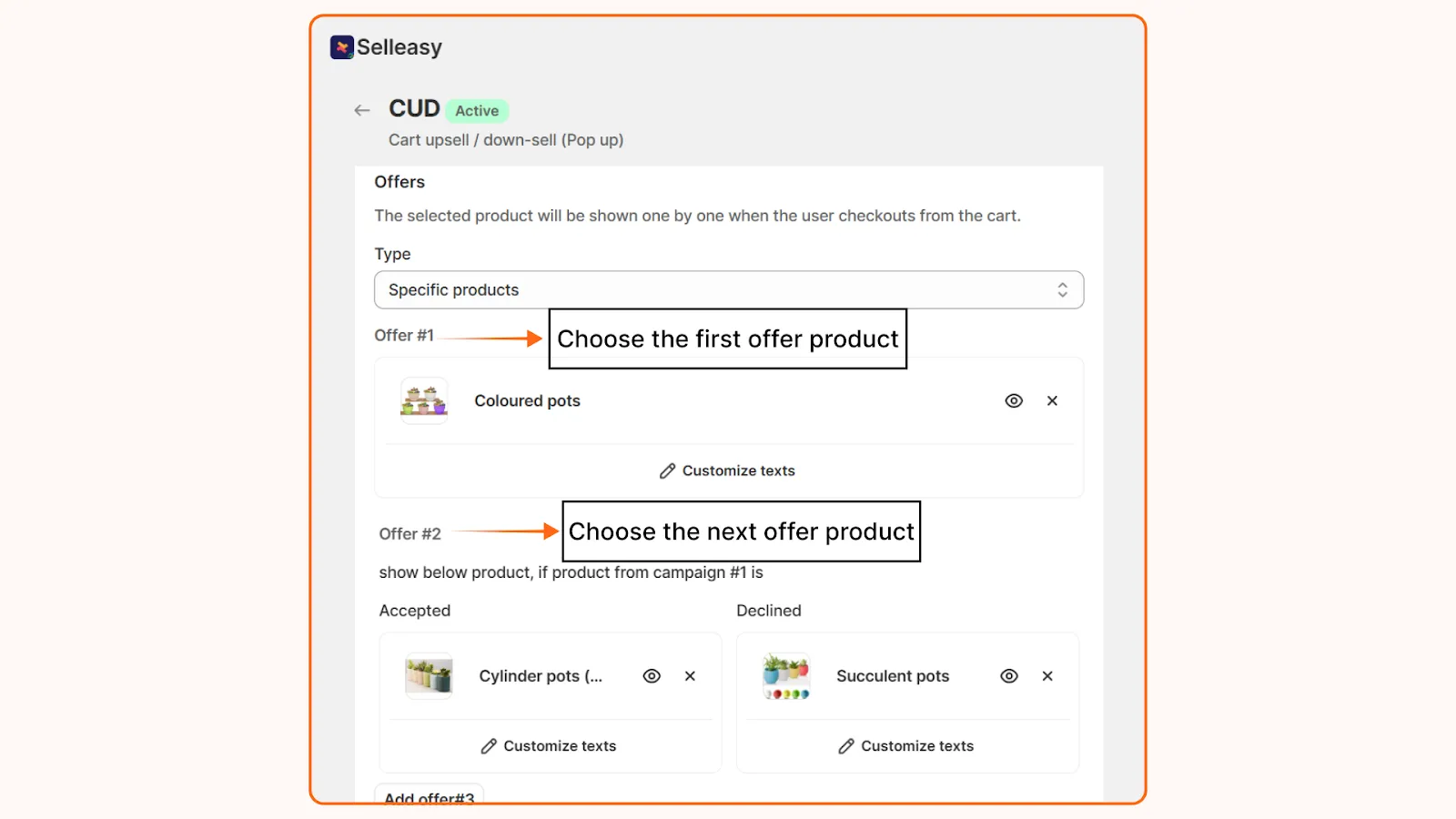
This approach works beautifully when the product is simple, low-cost, and easy to accept without much thinking - like a premium add-on, warranty, or a small complementary item.
Since the customer sees just one clear offer, it removes decision fatigue and often results in quick, impulse add-to-carts - which is perfect when you want minimal distraction and maximum conversion.

How to create a cart progress bar discount with gamification?
Install the Dealeasy app to enable this discount.
This app has the “Cart goals recommendation” offer, which can be used to show
- Free shipping
- Tiered discounts, or a
- Free gift with purchase.
Simply select the offer you want to promote and set the threshold value - the point at which the offer will appear on the progress bar.

This way, customers can clearly see how close they are to unlocking the reward, making it easy for them to take the next step and add more to their cart.
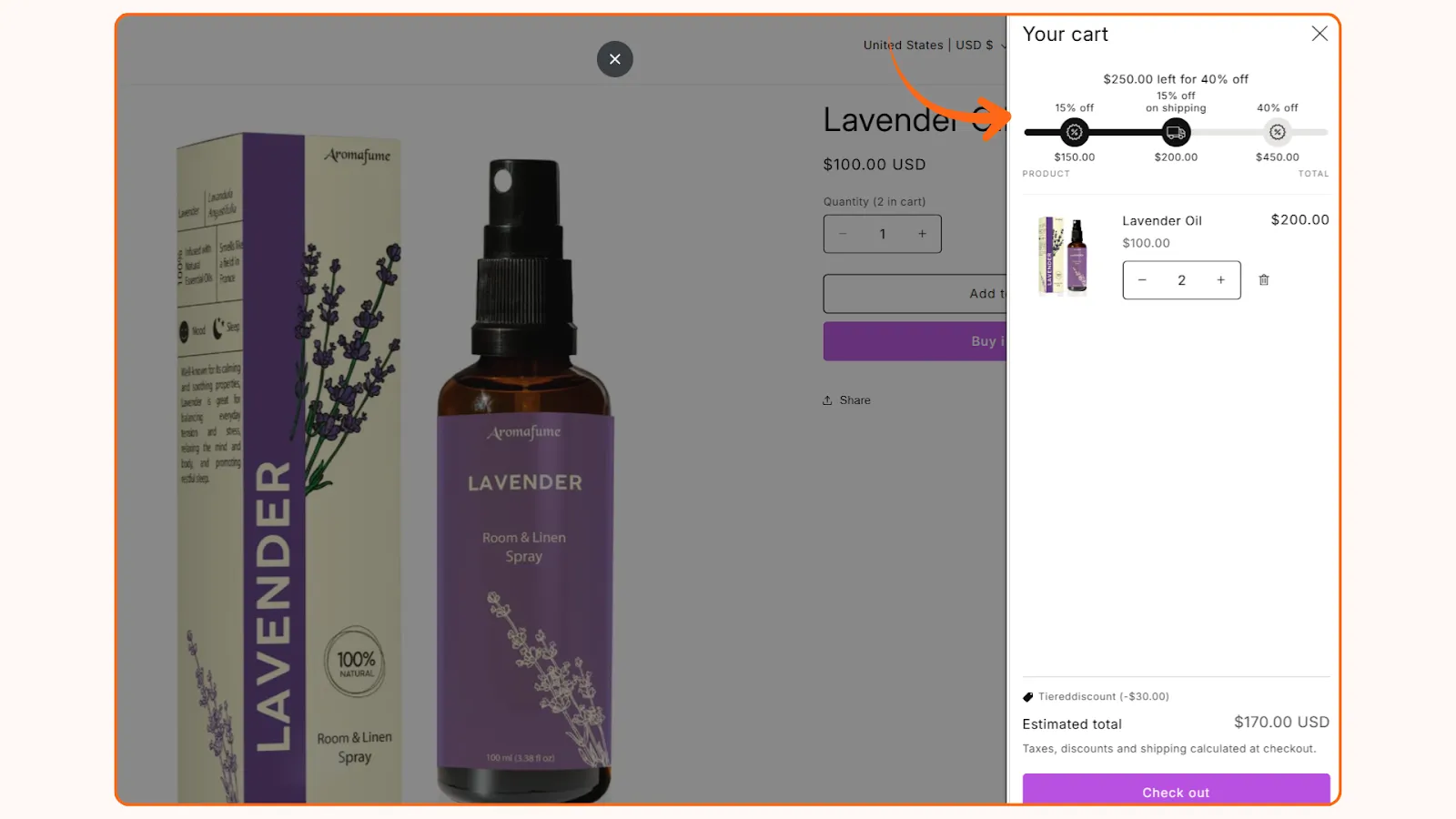
The progress bar can also be customised in three different ways. You can also change the text, colour, and font to match the look and feel of your store.

How to create a volume discount nudge in the cart?
Install the Dealeasy app.
This feature works hand-in-hand with your volume discount setup. It acts as a gentle nudge, encouraging customers to add more units of the same product so they can unlock a better discount.
First, create your volume discount offer. You can do this in two ways:
- Volume Discount Table – A clear pricing table on the product page showing how much they save at each quantity.
- Volume Discount Quantity Selector – Where customers can directly pick a higher quantity and see the discount applied instantly.
Once that’s set up, you can enable volume discount nudges from the customize section. These appear as subtle prompts like “Add 1 more to save 10%” - motivating customers to increase their cart value without being pushy.
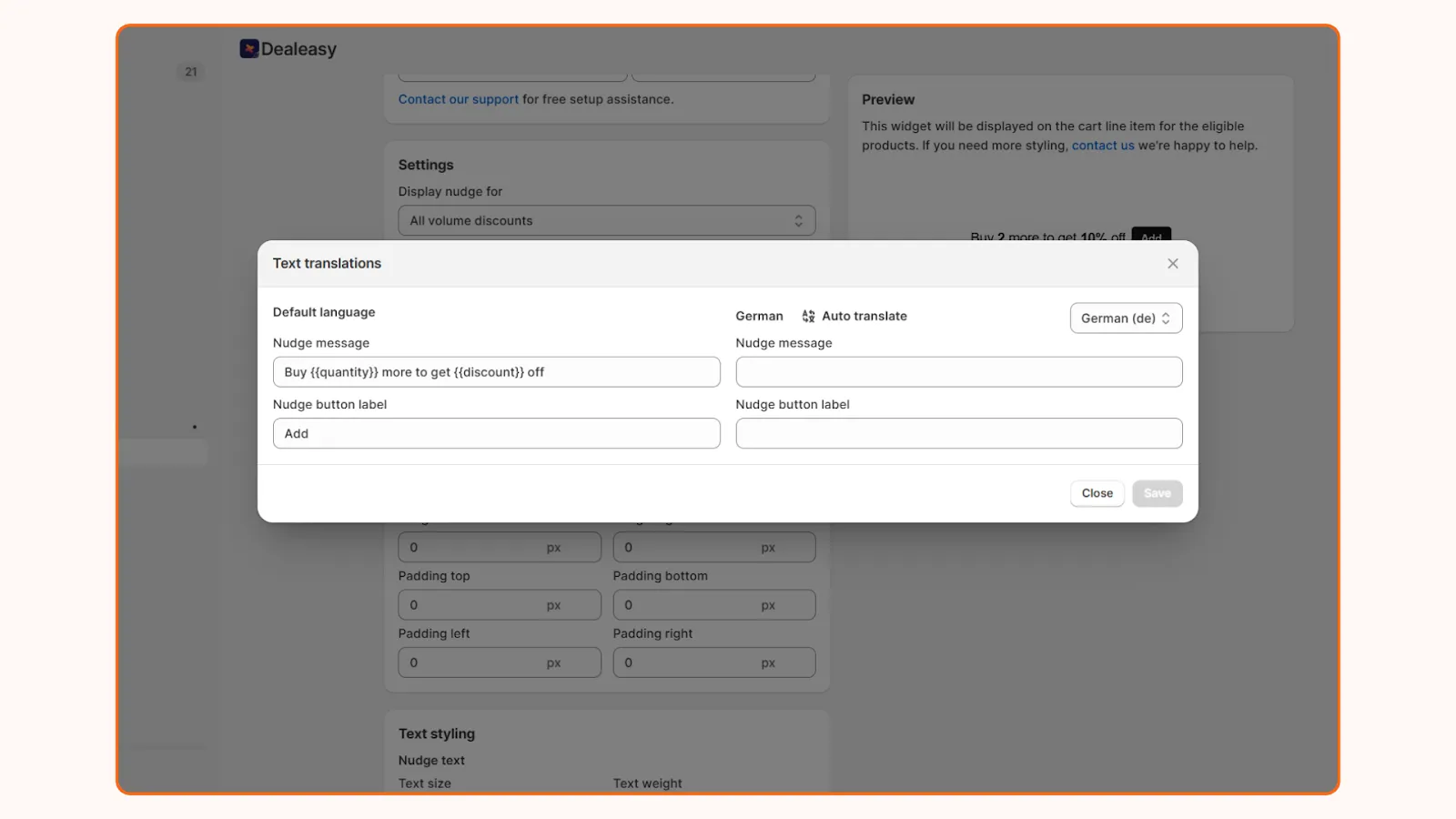
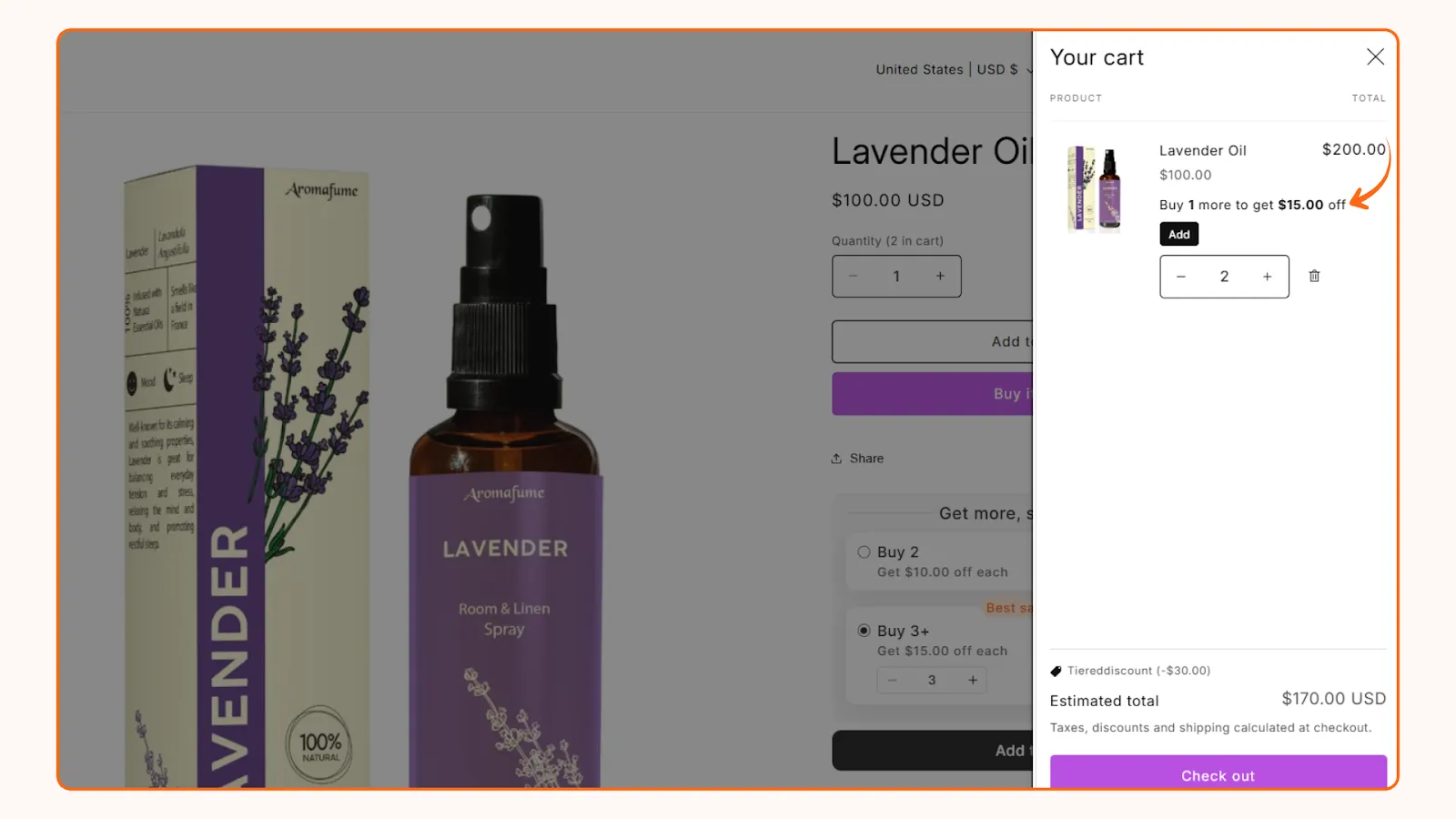
7 Expert tips to create a Shopify in cart upsell that actually works
Upselling in your Shopify store sounds simple, but done wrong, it can frustrate your customers and hurt your sales. Let’s go through the most common problems - and how to fix them - so you can create in cart upsells that feel natural, helpful, and irresistible.
.webp)
1. Only recommend relevant products
Ever added something to your cart and then got completely random suggestions? It’s annoying, right?
That’s the problem with irrelevant upsells - they feel pushy and make customers question your store.
The solution is simple: only recommend products that make sense. If someone’s buying a laptop, suggest a premium laptop sleeve or a RAM upgrade.
When your suggestions feel genuinely helpful, shoppers are much more likely to say yes.
2. Offer irresistible discounts or bundle savings
If your upsells are priced the same as regular products, customers have little reason to add them.
That’s why many upsells fail. Instead, make your offers feel special.
For example, “Buy this phone and get headphones for $150 instead of $180.”
Exclusive deals like this make your customers feel like they’re unlocking something valuable, and it encourages instant action.
3. Create urgency without being aggressive
One of the biggest reasons shoppers skip upsells is a lack of motivation.
Generic “limited-time offers” often feel spammy and push people away.
A better approach is subtle urgency: use timers, countdowns, or even a cart progress bar.
Show messages like:
- “You’re just $15 away from free shipping!”
- “Add 1 more item to unlock a free gift!”
This gamified, friendly approach encourages shoppers to add more naturally—without feeling pressured.
4. Make it easy to decline or remove
Forced upsells are a huge turn-off.
If a customer struggles to remove an offer, they might abandon the entire cart.
Keep it simple: include a “No thanks” button or a one-click remove option.
Giving shoppers control builds trust while still letting them consider your offer.
5. Tailor offers by cart value or product type
Showing the same upsell to every shopper is a mistake.
A premium add-on for someone buying $50 worth of items? Confusing.
Budget-friendly suggestions for a $1,000 cart? Overwhelming.
Use smart logic instead:
- Show premium add-ons only if the cart value is above $1,000.
- Show budget-friendly accessories if the cart value is under $500.
- This way, every customer sees the offer that actually makes sense for them.
6. Write compelling offer titles
Boring titles like “Add a planter” won’t inspire anyone. Your upsell needs to communicate value, not just list a product. Try titles like:
- “Add a self-watering planter - care-free plant maintenance!”
- “Complete your green corner & save 20% today!”
- When customers understand the benefits instantly, they’re far more likely to click “Add.”
7. Optimize for mobile-first shoppers
Most Shopify sales happen on mobile, yet many upsells aren’t designed for it. Slow-loading layouts, hidden buttons, or cluttered screens frustrate buyers and kill conversions.
The solution? Make mobile your priority: fast-loading upsells, clean designs, and visible core buttons like “Add to Cart” and “Checkout.”
A smooth mobile experience makes adding extras effortless.
Real store examples that use Shopify in cart upsells
1. Orchard, a mobile store uses cart upsells on the cart page to recommend accessories for the selected mobile phone.
This is a smart way to encourage customers to add more items to their cart and increase overall order value.
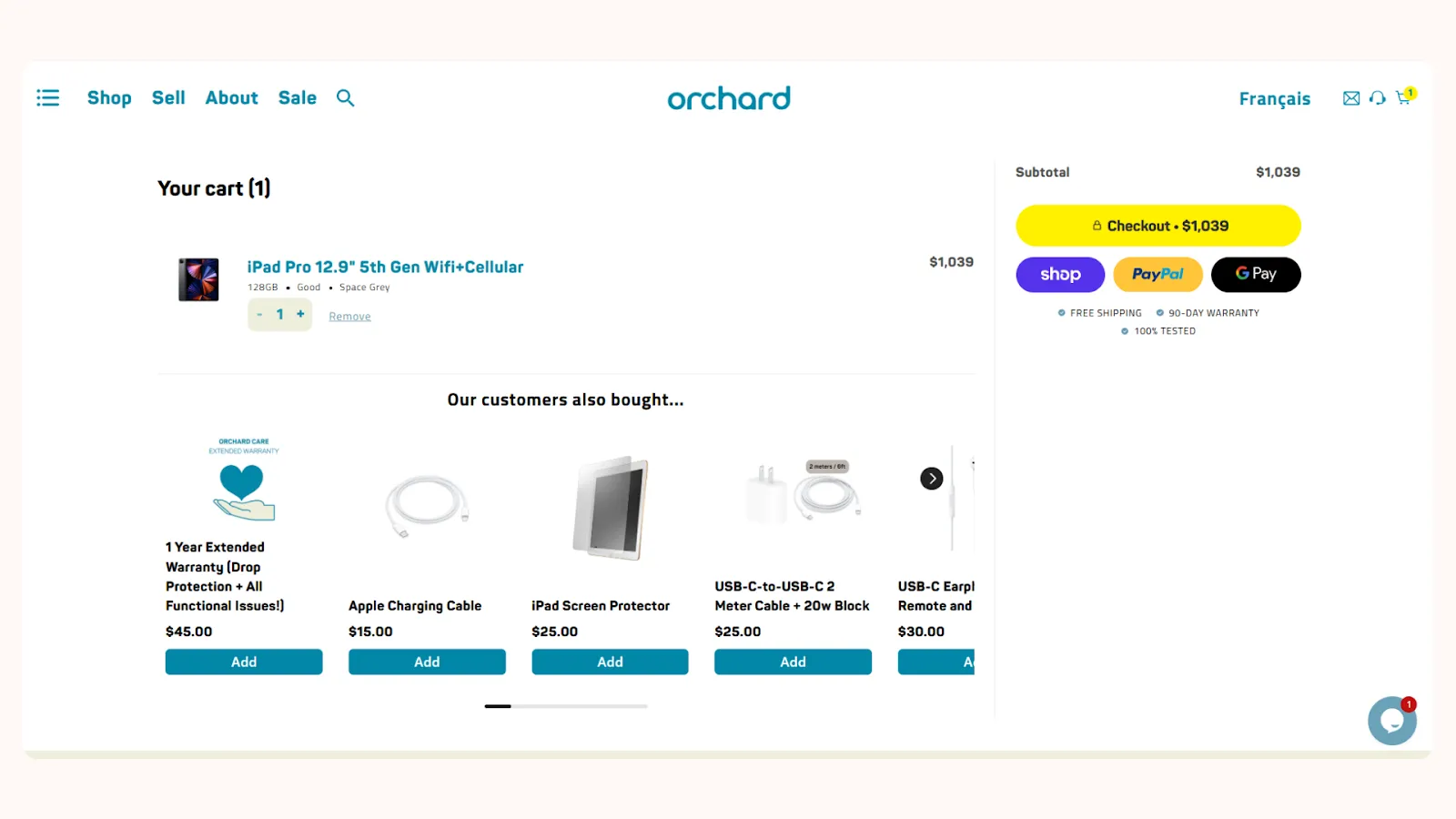
2. Leatherman, a tools and accessories store uses cart upsells in the cart drawer to recommend relevant accessories for their Super Tool.
These are add-ons the customer is likely to need, making it a smart way to promote upsells and boost average order value.
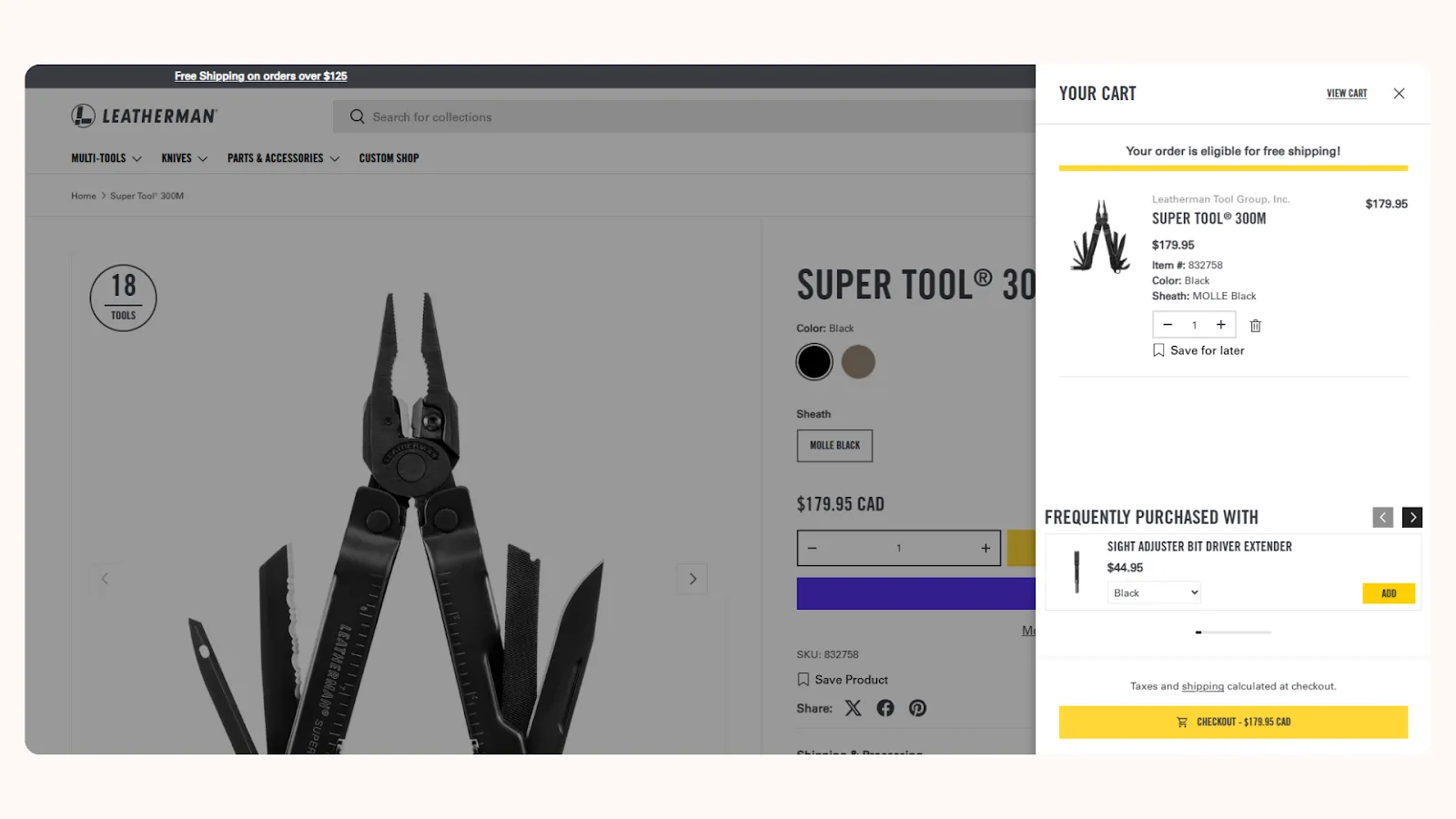
3. WIF, a beauty and cosmetic brand, uses a cart add-on pop-up to recommend essential wig care accessories at checkout, helping customers complete their purchase with the right add-ons.
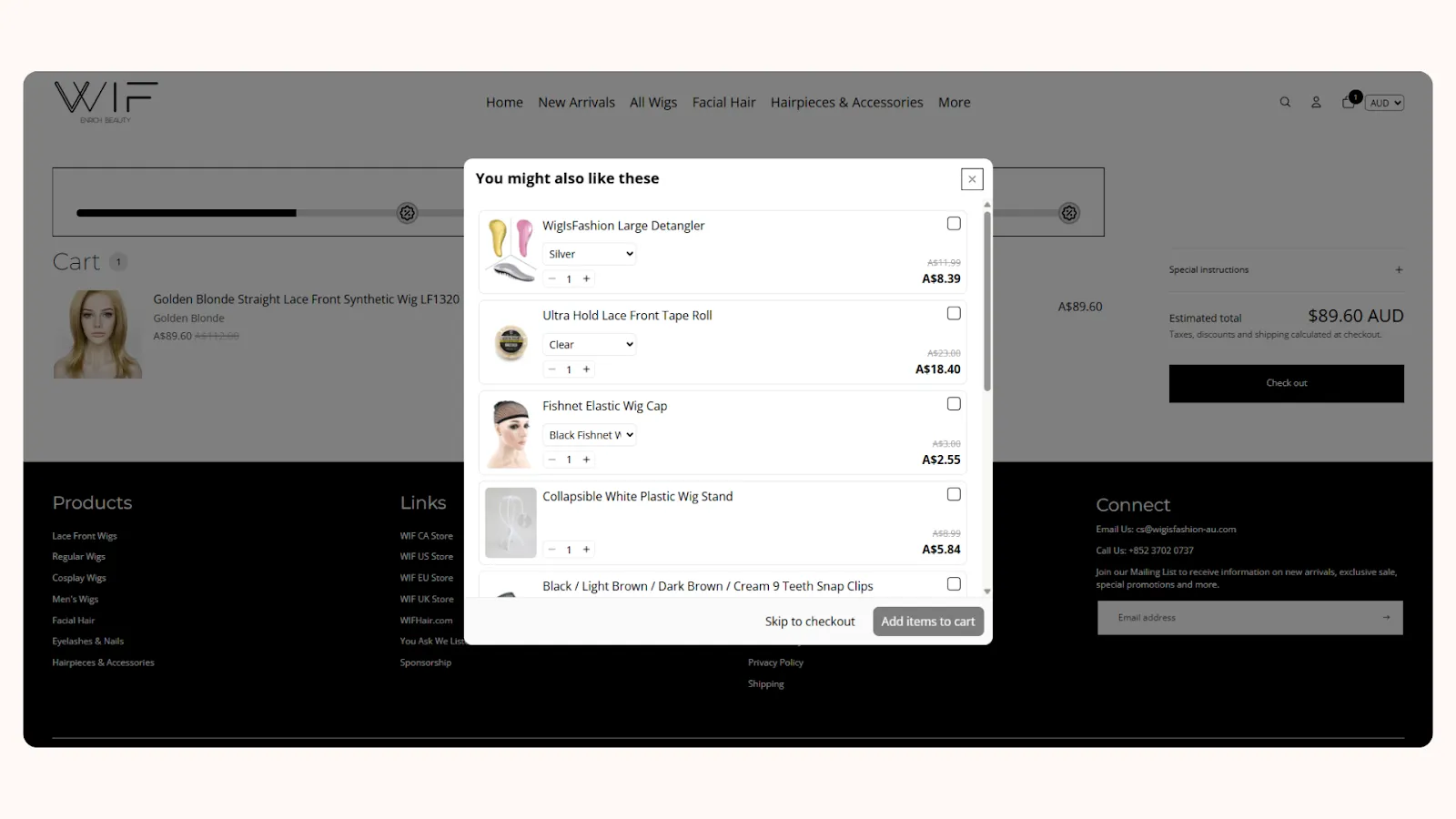
4. Bloomify, a plant and gardening accessories store, uses a cart progress bar to gently encourage customers to add more items to unlock rewards, effectively boosting their average order value.
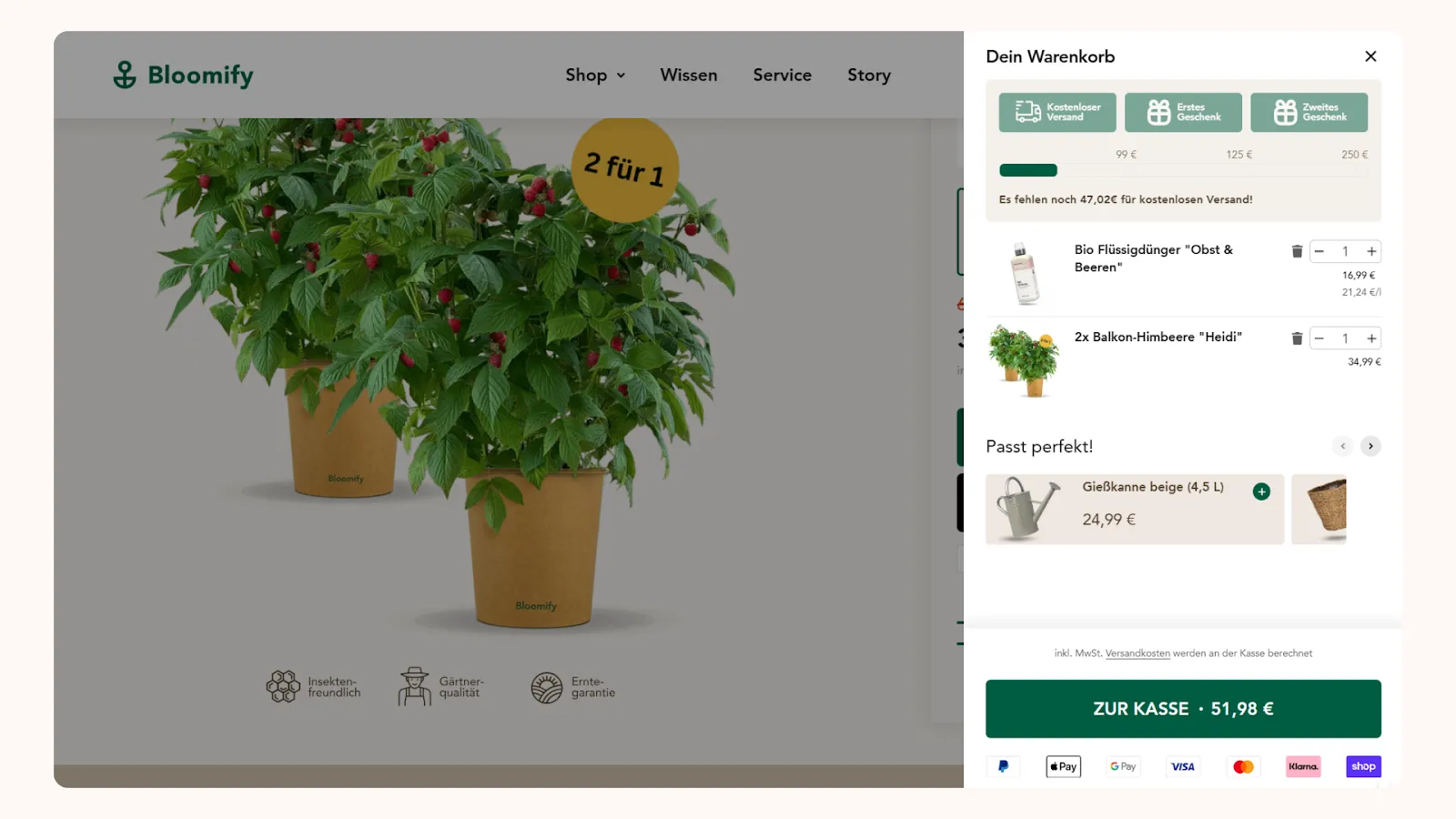
Can I do a Shopify in cart upsell without an app?
Yes, it’s possible to create a Shopify in cart upsell without using an app - but it requires working with custom liquid code.
This method is only recommended if you’re comfortable with development, as even a small error can prevent the upsell from showing at the right time.
It also isn’t easy to maintain, as every time you change your products or layout, you’ll need to manually update the code again.
So while this avoids using an app, it becomes time-consuming and less flexible in the long run.
How to do a Shopify in cart upsell using a dedicated cart drawer app?
Some Shopify merchants prefer using apps because they make in cart upsells fast, safe, and fully customizable - without the limitations of the default cart drawer.
You can use dedicated cart drawer apps like iCart Cart Drawer Cart Upsell, AMP Slide Cart Drawer, or UpCart – Cart Drawer Cart Upsell.
However, keep in mind - this applies mainly to apps that work alongside your cart, not apps that completely replace it.
Cart replacement apps often require deeper theme edits, and since they heavily modify your cart drawer, improper setup can cause layout or functionality issues.
What are the alternatives to Shopify in cart upsell without using a cart drawer app?
If you want to set up upsells without writing code or making any theme changes, apps like Selleasy let you create Shopify in cart upsell offers in just a few clicks.
You can customize offers based on product, cart value, or customer behavior, giving you precise control over who sees what.
These apps allow you to display in cart upsell offers directly inside the cart or slide cart drawer with a very simple setup, keeping customers on the same page for a fast and seamless checkout experience.
If you're not a developer, using an app is the smartest route.
It ensures fast setup, error-free performance, and higher conversion rates without any technical hassle.
Conclusion
Done right, a Shopify in cart upsell transforms a regular purchase into a higher-value, more satisfying shopping experience. By recommending relevant products, creating urgency, and optimizing for mobile, you can boost your average order value and delight your customers at the same time.
Frequently Asked Questions for Shopify In cart upsell
1. How do I add a cart upsell in Shopify?
You can add cart upsells in Shopify either with an app or without one. While it’s technically possible to set it up without an app using custom code, this approach requires development expertise and comes with limitations.
On the other hand, using a Shopify in cart upsell app makes the process effortless - you can enable powerful upsell offers in just a few clicks and get access to more flexible display and targeting options.
2. Does Shopify have an upsell feature?
Yes, Shopify supports in cart upsell features. You can set this up using third-party apps like Selleasy, or through custom code if you have strong technical expertise.
In cart upsells allow customers to add bundles or complementary add-on products directly within the shopping cart - just before checkout.
This creates a smoother shopping experience and significantly helps increase the average order value (AOV) of your store.
3. Can I offer free gifts as part of cart upsell?
Yes! With third-party apps like Dealeasy, you can offer free gifts as part of a cart upsell.
This can be set up with conditions such as reaching a minimum cart value or purchasing a specific quantity of a product.
4. What are the differences between cross-sell and upsell?
Upselling encourages customers to purchase a higher-end or premium version of the product they are already considering. It usually involves the same product line.
Cross-selling encourages customers to buy related or complementary products along with the main product.
While upselling increases the value of a single item, cross-selling helps boost the overall average order value of your store.
.svg)

.png)
.webp)
.avif)
.svg)
.svg)
.svg)


.svg)